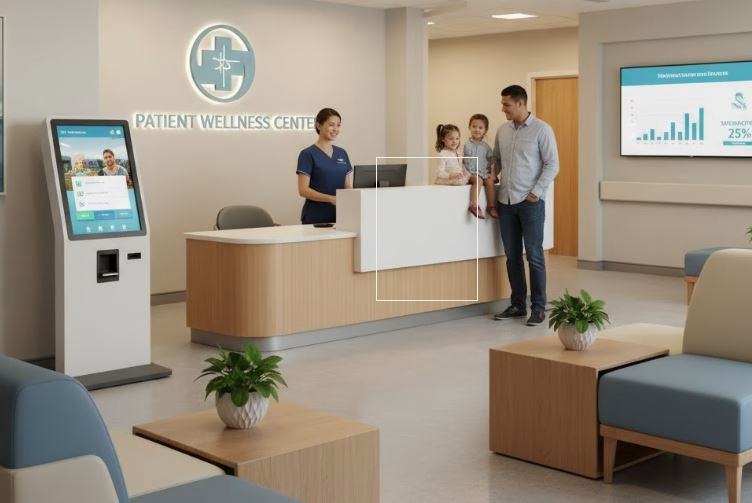Patient satisfaction scores have become increasingly important for medical practices. They affect online reviews, insurance reimbursements, and whether patients recommend the practice to friends and family.
What’s interesting is that many practices improving their scores aren’t changing their clinical care. The doctors are still the same. The treatment quality hasn’t changed. What’s different is how patients are being treated before they ever see the physician.
The upgrade is happening at the front desk, and it’s making a measurable difference.
Why Reception Matters More Than Practices Realized
Most patient satisfaction surveys ask about the entire experience, not just the medical care. How easy was it to schedule? Did someone answer when they called? Was the front desk staff friendly and helpful? Did they feel welcomed when they arrived?
These questions all relate to reception quality. And for many patients, these interactions shape their overall impression more than the five minutes they spend with the doctor.
A patient might have a great clinical outcome but leave a bad review because they sat on hold for fifteen minutes trying to schedule a follow-up. Another patient might rate the practice poorly because the front desk person seemed rushed and unfriendly, even though their medical care was excellent.
Practices that improve reception quality see their satisfaction scores rise across the board. Patients feel more valued. They’re more likely to keep appointments. They leave better reviews. The entire relationship with the practice improves when the front-end experience is positive.
The Coverage Consistency Problem
One major issue affecting patient satisfaction is inconsistent front desk coverage. When the main receptionist is at lunch, on break, or out sick, the quality of service often drops noticeably.
Calls go unanswered. Wait times increase. The backup person handling the desk doesn’t know all the procedures. Patients can tell when they’re getting less-than-ideal service, and it affects how they feel about the practice.
Practices improving their scores have found ways to maintain consistent reception quality regardless of who’s working or what time patients call. The experience stays professional and responsive whether it’s Tuesday morning or Friday afternoon, whether the regular staff is there or not.
Some have done this by bringing in additional in-house staff to ensure coverage gaps don’t happen. Others have found it more practical to hire a virtual medical receptionist who can handle calls and scheduling during busy periods, breaks, and absences. The key is eliminating the variability that creates frustrating patient experiences.
The Response Time Factor
Patients notice how long they wait on hold. They notice how quickly their messages get returned. They notice whether scheduling an appointment takes two minutes or twenty.
Fast response times correlate strongly with higher satisfaction scores. When patients can reach someone quickly and get their needs handled efficiently, they rate the practice higher. When they’re waiting and waiting, scores drop even if everything else is perfect.
Practices making improvements have focused on reducing response times across the board. Fewer rings before calls get answered. Faster callback times for voicemails. Quicker resolution of scheduling questions. These aren’t huge operational changes, but they have outsized impact on how patients perceive the practice.
The challenge is maintaining quick responses during busy periods when multiple patients need attention at once. Practices solving this have found ways to add capacity during peak times rather than making patients wait because staff is overwhelmed.
The Professionalism and Friendliness Balance
How reception staff interact with patients significantly affects satisfaction scores. Patients want to feel welcomed and valued, but they also want to feel like they’re dealing with competent professionals who know what they’re doing.
Practices with improving scores have invested in better training for reception staff. Not just technical training on the computer systems, but communication training. How to handle difficult conversations. How to stay calm with frustrated patients. How to project warmth while remaining professional.
This training pays off in patient interactions. When someone calls upset about a bill and the receptionist handles it smoothly without getting defensive, that patient’s overall impression of the practice improves. When someone’s confused about their appointment and gets a clear, patient explanation, they feel cared for.
The best receptionists make patients feel like their concerns matter and will be addressed properly. This isn’t about being overly cheerful or fake—it’s about genuine professionalism combined with empathy.
The Scheduling Experience Overhaul
A surprising number of patient complaints relate to scheduling hassles. Difficulty getting appointments. Confusing processes. Long wait times for available slots. Unclear instructions about what to do before the visit.
Practices improving their scores have streamlined their scheduling processes. They’ve made it easier to book appointments, clearer what patients need to do to prepare, and more transparent about wait times and availability.
Some have added online scheduling so patients can book at their convenience without calling. Others have improved their phone scheduling process to make it faster and less confusing. The specific solution matters less than the result—patients finding it easy and pleasant to schedule their care.
Better scheduling also means fewer no-shows, which helps practices run more efficiently. When patients have a smooth scheduling experience and clear confirmation of their appointment, they’re much more likely to show up.
The First Impression Impact
The first interaction a new patient has with a practice often determines whether they keep that appointment or cancel and try somewhere else. A warm, efficient initial contact creates confidence. A frustrating one sends patients looking for alternatives.
Practices focusing on satisfaction scores pay special attention to that first phone call or first visit. How quickly do new patient calls get answered? How helpful is the staff in explaining what to expect? How welcoming is the office when someone walks in for the first time?
These initial impressions are hard to overcome if they’re negative. But when they’re positive, they create a foundation of goodwill that carries through the entire patient relationship.
The Follow-Up That Makes a Difference
Another area where reception quality affects satisfaction is follow-up communication. Did someone call back about test results when they said they would? Did the practice reach out to reschedule a canceled appointment? Did they follow up after a procedure to see how the patient was doing?
These touches show patients the practice cares about them beyond just billing for services. They feel looked after rather than processed. And they mention these positive interactions in reviews and satisfaction surveys.
Practices with strong satisfaction scores have systems ensuring these follow-ups happen consistently. It’s not left to chance or individual staff members remembering. There are processes and accountability for making sure patients get the communication they need when they need it.
The Measurable Results
Practices making these reception improvements see concrete results. Online review ratings increase. Patient satisfaction survey scores go up. Patient retention improves. Referrals increase because satisfied patients tell friends and family about their positive experiences.
These improvements also help with insurance reimbursements tied to patient satisfaction metrics. Better scores can mean better payment rates, which directly impacts practice revenue.
But beyond the numbers, there’s a noticeable difference in the overall atmosphere of the practice. When patients feel well-treated from their first contact, they’re more pleasant to work with. They’re more understanding when things don’t go perfectly. They’re more compliant with treatment plans. The entire dynamic improves.
The Long-Term Competitive Advantage
As patients have more choices about where to receive care, practices that provide excellent front-desk experiences will have an advantage. Patients remember how they were treated when they called to schedule. They remember whether the front desk staff was helpful or dismissive. They remember whether getting care was easy or a hassle.
These memories influence where they go for future care and what they tell others. In a competitive healthcare market, reception quality is becoming a differentiator that matters as much as clinical reputation.
The practices investing in reception improvements now are building loyalty and reputation that will pay dividends for years. They’re creating patient experiences that stand out in positive ways, and their satisfaction scores reflect it.
Read Next:
- Innovative Trends in Medical Device Packaging and Why Consultants Matter
- Exploring Elderly Living Options: Finding the Right Fit for Seniors





